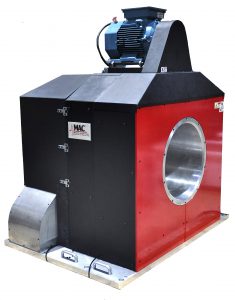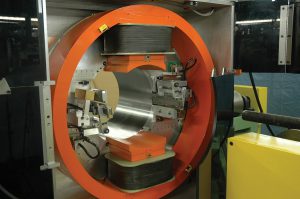ROTOFLUX® MULTICHANNEL MFL
Nondestructive Flux Leakage Test Systems That Accurately Show Defects in Heavy Wall Magnetic Tubing
- Accurately tests oil country tubular goods (OCTG), bars and parts at test speeds up to 700 FPM.
- Offers 24 separate channels for longitudinal and 48 channels for transverse defect detection.
- LRFX rotaries use transverse magnetism to find longitudinal defects such as seams, laps and weld line defects.
- TRFX rotaries use longitudinal magnetization and provide 100% surface coverage to detect transverse defects.
- Both rotary types detect pits, scabs, slivers, gouges, roll-ins, cracks and holes depending on defect orientation.
- Differentiates between OD and ID defects.
- Detects longitudinal and transverse defects as small as 5% on OD and ID, depending upon material type and condition.
- System provides 100% surface coverage to detect transverse defects.
- Systems are available to test up to 500mm diameter and 19mm wall thickness tubes

Transverse Rotoflux® Rotary
MAC’s Rotoflux® Multiplex Electronics—Magnetic Flux Leakage testing that provides superior technology, performance and versatility.
Features:
- Transverse and longitudinal defect detection meets API standards for OCTG products plus critical API 5CT and 5L, ASTM E570, and ISO requirements.
- Multiplex probe system allows individual probe signal adjustment for accurate defect location and marking.
- Retractable probe assemblies accurately test upset and irregular ends.
- All standard parameters, including sensitivity, filters, and thresholds for each probe are set through on-screen menus.
- Each probe can be independently adjusted, or automatically calibrated, for gain or sensitivity on-screen.
- Compatible with Windows® OS platform to store results and unlimited setups.
- Software controlled setup of flaw track output delay, applicable to any of six outputs, and end suppression.
- Special operation mode can suppress signals from acceptable welds in welded steel.
- On screen guide helps operators differentiate between most ID and OD defects.
- Color-coded triangles help highlight the defect signals.
MAGNETIC FLUX LEAKAGE TECHNOLOGY IN NDT
Magnetic Flux Leakage (MFL) nondestructive test systems accurately detect defects in heavy-wall magnetic tubing, including oil country tubular goods (OCTG).
These electromagnetic test methods are also used to inspect high-permeability ferromagnetic metals such as carbon steel bar, plate, wire rope and parts. The method can also be used to detect ferritic inclusions in non-ferritic material.
- For typical OCTG and other heavy wall tube tests, Flux Leakage technology detects longitudinal and transverse defects as small as 5% on OD and ID, as well as defects within the wall, depending upon material type and condition.
- MFL inspection uses a DC magnetizing field to create enough flux density to bring the material to near-saturation. A transverse magnetizing field is used to detect longitudinally oriented defects, while a longitudinal field is used to find transverse defects.
- Surface or internal conditions such as cracks, pits, seams and other defects interrupt the flux field and “leak” beyond the product surface.
- This leakage flux is detected by flux sensor probes with MAC configured rotary inspection devices which can wirelessly transmit this data to the instrumentation for processing and analysis.

Longitudinal Rotoflux® Rotary Assembly

